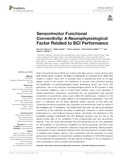Mostrar el registro sencillo del ítem
Sensorimotor functional connectivity: a neurophysiological factor related to BCI performance
| dc.creator | Vidaurre, Carmen | es_ES |
| dc.creator | Haufe, Stefan | es_ES |
| dc.creator | Jorajuría, Tania | es_ES |
| dc.creator | Müller, Klaus Robert | es_ES |
| dc.creator | Nikulin, Vadim V. | es_ES |
| dc.date.accessioned | 2021-06-16T08:48:56Z | |
| dc.date.available | 2021-06-16T08:48:56Z | |
| dc.date.issued | 2020 | |
| dc.identifier.issn | 1662-4548 | |
| dc.identifier.uri | https://hdl.handle.net/2454/39933 | |
| dc.description.abstract | Brain-computer interfaces (BCIs) are systems that allow users to control devices using brain activity alone. However, the ability of participants to command BCIs varies from subject to subject. About 20% of potential users of sensorimotor BCIs do not gain reliable control of the system. The inefficiency to decode user's intentions requires the identification of neurophysiological factors determining 'good' and 'poor' BCI performers. One of the important neurophysiological aspects in BCI research is that the neuronal oscillations, used to control these systems, show a rich repertoire of spatial sensorimotor interactions. Considering this, we hypothesized that neuronal connectivity in sensorimotor areas would define BCI performance. Analyses for this study were performed on a large dataset of 80 inexperienced participants. They took part in a calibration and an online feedback session recorded on the same day. Undirected functional connectivity was computed over sensorimotor areas by means of the imaginary part of coherency. The results show that post- as well as pre-stimulus connectivity in the calibration recording is significantly correlated to online feedback performance in μ and feedback frequency bands. Importantly, the significance of the correlation between connectivity and BCI feedback accuracy was not due to the signal-to-noise ratio of the oscillations in the corresponding post and pre-stimulus intervals. Thus, this study demonstrates that BCI performance is not only dependent on the amplitude of sensorimotor oscillations as shown previously, but that it also relates to sensorimotor connectivity measured during the preceding training session. The presence of such connectivity between motor and somatosensory systems is likely to facilitate motor imagery, which in turn is associated with the generation of a more pronounced modulation of sensorimotor oscillations (manifested in ERD/ERS) required for the adequate BCI performance. We also discuss strategies for the up-regulation of such connectivity in order to enhance BCI performance. | en |
| dc.description.sponsorship | CV was supported by MINECO-RyC-2014-15671. SH was supported by the European Research Council (ERC) under the European Union’s Horizon 2020 research and innovation programme (Grant agreement No. 758985). K-RM was supported in part by the Institute for Information & Communications Technology Promotion and funded by the Korea government (MSIT) (No. 2017-0-00451), and was partly supported by the German Ministry for Education and Research (BMBF) under Grants 01IS14013A-E, 01GQ1115, 01GQ0850, 01IS18025A, and 01IS18037A; the German ResearchFoundation (DFG) under Grant Math+, EXC 2046/1, Project ID 390685689. VVN was partly supported by the HSE Basic Research Program and the Russian Academic Excellence Project 5-100. | en |
| dc.format.extent | 13 p. | |
| dc.format.mimetype | application/pdf | en |
| dc.language.iso | eng | en |
| dc.publisher | Frontiers Media | en |
| dc.relation.ispartof | Frontiers In Neuroscience, December 2020, volume 14, article 575081 | en |
| dc.rights | © 2020 Vidaurre, Haufe, Jorajuría, Müller and Nikulin. This is an open-access article distributed under the terms of the Creative Commons Attribution License (CC BY). The use, distribution or reproduction in other forums is permitted, provided the original author(s) and the copyright owner(s) are credited and that the original publication in this journal is cited, in accordance with accepted academic practice. No use, distribution or reproduction is permitted which does not comply with these terms. | en |
| dc.rights.uri | http://creativecommons.org/licenses/by/4.0/ | |
| dc.subject | BCI efficiency | en |
| dc.subject | BCI performance | en |
| dc.subject | Connectivity | en |
| dc.subject | Pre-stimulus | en |
| dc.subject | Sensorimotor signals | en |
| dc.subject | μ-Band | en |
| dc.title | Sensorimotor functional connectivity: a neurophysiological factor related to BCI performance | en |
| dc.type | info:eu-repo/semantics/article | en |
| dc.type | Artículo / Artikulua | es |
| dc.contributor.department | Estadística, Informática y Matemáticas | es_ES |
| dc.contributor.department | Estatistika, Informatika eta Matematika | eu |
| dc.rights.accessRights | info:eu-repo/semantics/openAccess | en |
| dc.rights.accessRights | Acceso abierto / Sarbide irekia | es |
| dc.identifier.doi | 10.3389/fnins.2020.575081 | |
| dc.relation.projectID | info:eu-repo/grantAgreement/European Commission/Horizon 2020 Framework Programme/758985 | en |
| dc.relation.projectID | info:eu-repo/grantAgreement/MINECO//RYC-2014-15671/ES/ | en |
| dc.relation.publisherversion | https://doi.org/10.3389/fnins.2020.575081 | |
| dc.type.version | info:eu-repo/semantics/publishedVersion | en |
| dc.type.version | Versión publicada / Argitaratu den bertsioa | es |
Ficheros en el ítem
Este ítem aparece en la(s) siguiente(s) colección(ones)
La licencia del ítem se describe como © 2020 Vidaurre, Haufe, Jorajuría, Müller and Nikulin. This is an open-access article distributed under the terms of the Creative Commons Attribution License (CC BY). The use, distribution or reproduction in other forums is permitted, provided the original author(s) and the copyright owner(s) are credited and that the original publication in this journal is cited, in accordance with accepted academic practice. No use, distribution or reproduction is permitted which does not comply with these terms.



